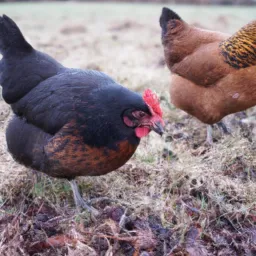The Surprising Truth About Chicken Eyes: Debunking Common Myths about Avian Vision
Chickens are fascinating creatures that have been a part of human lives for centuries.
From their humble beginnings as farm animals to becoming beloved pets, chickens continue to captivate us with their unique personalities and behaviors.
One aspect of chickens that often goes overlooked is their eyesight.
Now, we’ll explore the surprising truth about chicken eyelids, debunk common myths about avian vision, and uncover some interesting facts about chicken colors.
What Do We Know About Chicken Eyes?
One thing you may not know about chicken eyes is that they actually have three eyelids!
The third eyelid, also known as the nictitating membrane, helps protect the eye from dust and debris while allowing the chicken to still see.
This makes it an essential tool for keeping the eye healthy in the wild.
Additionally, chickens have excellent peripheral vision which allows them to detect movement around them at all times.
However, despite having such impressive vision, chickens are colorblind.
They can only distinguish between shades of gray and cannot see any other colors.
So they say…
I can not see this, otherwise, they would not have such colour variations and such a bright comb and wattles for courtship.
The Truth about Chicken Eyelids
Another misconception about chicken eyelids is that they blink frequently like humans do.
While chickens do use their eyelids to keep their eyes clean and moisturized, they don’t necessarily blink as much as people might think.
Instead, they rely on their nictitating membrane to shield their eyes from harmful particles.
So if you ever notice your chicken squinting or rubbing its eyes, it could be due to irritation rather than fatigue.
See also Become An Insider On Clipping A Chickens Wings
Debunking Common Myths about Avian Vision
One common myth about avian vision is that birds can see ultraviolet light.
While it’s true that some species of birds, including pigeons and songbirds, can see UV light, chickens are not one of them.
As previously mentioned, chickens are colorblind and can only see shades of gray.
Another myth is that birds have better vision than humans.
While it’s true that many bird species have exceptional eyesight, chickens aren’t among them.

Their visual acuity is comparable to that of humans, but their field of view is wider.
Exploring the World of Chicken Colors and Their Impact on Behavior
Did you know that there are hundreds of different breeds of chickens, each with its own distinct color pattern?
Some popular breeds include:
- Rhode Island Reds
- Leghorns
- Plymouth Rocks
These variations in color can impact behavior, particularly when it comes to mating rituals.
For example, male chickens will often display bright plumage during courtship to attract females.
Also, studies have shown that certain colors of chickens can affect egg production rates, with white eggs being more productive than brown ones.
How to Use This Information in Your Own Backyard
Now that you know more about chicken eyes and how they work, what can you do with this information in your own backyard?
Well, first off, make sure to provide plenty of natural sunlight for your chickens so they can benefit from their excellent peripheral vision.
You should also ensure that their living conditions are clean and well-ventilated to prevent eye irritations.
See also Everything You Need to Know About Rhode Island Reds
Finally, consider incorporating different colored chickens into your flock to observe how their behavior changes based on their appearance.
